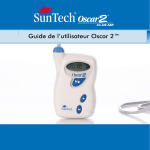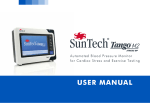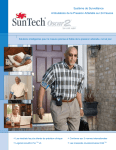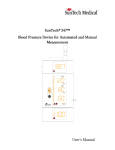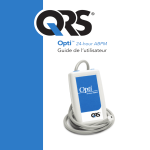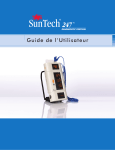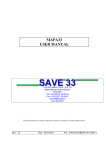Download User Guide - SunTech Medical
Transcript
® U s e r G u id e Table of Contents Introduction to Ambulatory Blood Pressure Monitoring.................. 4 Introduction to the Oscar 2 ABP System........................................ 5 Indications for Use....................................................................... 5 Operation................................................................................... 5 Products and Accessories.............................................................. 6 Specifications.............................................................................. 7 Safety and Effectiveness Considerations........................................ 8 Warnings and Contraindictions.....................................................9 Oscar 2 at a Glance...................................................................10 Setting Up the Sytem.................................................................11 Hardware Requirements............................................................. 11 Software Requirements............................................................... 11 Powering the Oscar 2 for use...................................................... 11 Setting Up the System................................................................12 Installing the Software................................................................ 12 Conducting an Ambulatory Blood Pressure Study........................ 13 Programming the Oscar 2 for an ABP Study................................. 14 Fitting a Patient with the Oscar 2 and Orbit™ Cuff....................... 15 Preparing and Educating the Patient............................................ 16 Starting the Study....................................................................... 16 Finishing the Study..................................................................... 16 Troubleshooting.........................................................................18 Maintaining and Cleaning the Oscar 2....................................... 19 Limited Warranty........................................................................21 Index.........................................................................................22 4 Introduction to Ambulatory Blood Pressure Monitoring Ambulatory blood pressure monitoring is an accepted clinical tool for collecting multiple blood pressure measurements. It better assists clinicians with the diagnosis and management of hypertension by providing: blood pressure variability, an estimation of true blood pressure, overnight changes in blood pressure, and morning surge in blood pressure.1 In-clinic and home blood pressure measurements cannot provide the same depth of information that a 24-hour study provides. Several studies have shown that ambulatory blood pressure monitoring, when compared to clinic or home blood pressure measurements, is superior in predicting target organ damage, morbid events, or cardiovascular risk.1, 2, 3 The data obtained from ambulatory blood pressure monitors is highly accurate and useful for managing a wide variety of hypertensive situations including: • • • • • • • • • • White-coat hypertension Resistant hypertension Masked hypertension Childhood hypertension Efficacy of anti-hypertensive drug therapy on a 24-hour basis Nocturnal hypertension Episodic hypertension and/or anxiety disorders Hypotensive symptoms Changes in diet and daily routine designed to reduce hypertension Hypertension in pregnancy 1. Pickering, T.G., Shimbo, D., & Haas, D. (2006). Ambulatory Blood-Pressure Monitoring. New England Journal of Medicine, 354(22), 2368 – 2374. 2. Marchiando, R.J. & Elston, M.P. (2003). Automated Ambulatory Blood Pressure Monitoring: Clinical Utility in the Family Practice Setting. American Family Physician, 67(11), 2343 – 2350. 3. White, W.B. (1999). Ambulatory blood pressure as a predictor of target organ disease and outcomes in the hypertensive patient. Blood Pressure Monitoring, 4(3), 181 – 184. 5 Introduction to the Oscar 2 ABP System Indications for Use The Oscar 2 is a non-invasive oscillometric blood pressure monitor capable of measuring systolic and diastolic blood pressures of pediatric (over 3 years old) and adult patients. It is intended for use as an aid or adjunct to diagnosis and treatment. Operation The Oscar 2 unit is worn by the patient either on a waist belt or shoulder strap and is connected to a cuff around the non-dominant upper arm. The cuff is inflated automatically at intervals which can be programmed during setup. Blood pressure is measured by the oscillometric method which senses pressure waves in the artery when occluded by pressure in the cuff. Measurement of the frequency of the pressure waves enables heart rate to also be measured. Blood pressure measurements determined with this device are equivalent to those obtained by a trained observer using the cuff/stethoscope auscultation method, within the limits prescribed by the American National Standard, Electronic or Automated Sphygmomanometers.1 The Korotkoff sounds heard over the artery below the compression cuff vary in character as the pressure in the cuff is reduced from above systolic toward zero or atmospheric pressure. They are divided into phases. Phase 1 (K1) or systolic begins with the sudden appearance of a faint, clear tapping or thumping sound that gradually increases in intensity. Phase 5 (K5) or diastolic begins when silence develops, and was used to determine overall efficacy of the Oscar 2. The Oscar 2 passes all requirements for validation by the International Protocol of the European Society of Hypertension (ESH)2 and British Hypertension Society (BHS)3. To obtain results of these studies please send a written request to : SunTech Medical® 507 Airport Boulevard, Suite 117 Morrisville, NC 27560-8200 USA 1. Association for the Advancement of Medical Instrumentation. The National Standard of Electronic or Automated Sphygmomanometer. Arlington, VA: AAMI; 1996 2. Jones, S. C., Bilous, M., Winship, S., Finn, P., & Goodwin, J. (2004). Validation of the Oscar 2 oscillometric 24-hour ambulatory blood pressure monitor according to the International Protocol for the validation of blood pressure measuring devices. Blood Press Monitoring, 9(4), 219-223 3. Goodwin, J., Bilous, M., Winship, S., Finn, P., & Jones, S. (2007). Validation of the Oscar 2 oscillometric 24-h ambulatory blood pressure monitor according to the British Hypertension Society protocol. Blood Pressure Monitoring, 12(2), 113 – 117. 6 Products and Accessories Your Oscar 2 package should contain the following items. If you are missing any item please contact SunTech immediately (refer to Limited Warranty, page 21, for contact information). Oscar 2 Package Item Number Qty. Standard Oscar 2 ABP Monitor 97-0012-00 1 AccuWin Pro™ v3 Software (CD) 27-0037-A1 1 Oscar 2 USB Cable 97-0090-02 1 Oscar 2 Serial Cable 91-0056-00 1 Adult Orbit Cuff (25-35 cm) 98-0063-12 1 Adult Plus Orbit Cuff (33-40 cm) 98-0063-13 1 Oscar 2 Pouch 98-0032-00 1 Oscar 2 Strap 98-0036-00 1 Oscar 2 Belt 98-0037-00 1 Oscar 2 User’s Guide 80-0027-00 1 Oscar 2 Quick Start Guide 82-0026-00 1 AccuWin Pro v3 User’s Guide 80-0026-00 0 Patient Diaries 82-0019-00 10 AA, Alkaline Batteries (qty. 4) 17-0004-00 1 Additional Accessories (included in the Power Pack System Item Number Qty. Standard Small Adult Orbit Cuff (18-27 cm) 98-0063-11 0 Large Adult Orbit Cuff (39-46 cm) 98-0063-14 0 AA, NiMH Rechargeable Batteries (qty. 4) 17-0005-00 0 Battery Charger 17-0007-00 0 7 Specifications Method of Measurement: Oscillometry with step deflation Blood Pressure Range: 25-260 mmHg (max inflate 280mmHg) Heart Rate Range: 40-200 bpm Accuracy: Clinically validated to ESH International Protocol, BHS (A/A), ANSI/AAMI (SP10) International Standards: EN 60601-1, EN 60601-2-30, EN 60601-1-2 (EMC), EN 1060-1, EN 1060-3, “Non-Invasive Sphygmomanometers -General Requirements & Supplementary Requirements For ElectroMechanical BP Measuring Systems”, AAMI SP10 ES1 category C’ (battery powered) Operating Conditions: 10°C (50°F) to 50°C (122°F) 20-95% RH non-condensing Power: Two “AA” alkaline batteries or high capacity rechargeable batteries (NiMH) Data Memory: Flash memory stores up to 250 readings Calibration: Minimally, once every two years Safety Systems: Maximum inflation pressure limited to 300 mmHg; Auto safety release valve for power failure; Maximum BP measurement time limited to less than 140 seconds Sampling Periods: 3 independently programmable periods (5, 10, 15, 20, 30, 45, 60, 90 and 120 minutes) Size: Approximately 120 x 70 x 32 mm Weight: Approx 284g, including batteries Storage Conditions: -20°c to 70°c, 15%-95% RH non-condensing Data Connection: USB (RS-232 option) 8 Safety and Effectiveness Considerations The following safety and effectiveness issues are to be considered prior to the usage of the Oscar 2 unit. • This device is defibrillator protected. NOTE: No precautions specific to the Oscar 2 are required during defibrillation, and defibrillation discharge has no effect on the Oscar 2. • The monitor is intended for use following consultation and instruction by a physician. • The reliability of the device is dependent upon conformance with the operation and service instructions, as detailed in this manual. • This device has been designed for use on patients with normal sinus rhythms. • The interpretation of blood pressure measurements should only be made by a physician. The accuracy of any blood pressure recording may be affected by the position of the subject, his or her physical condition, and use outside the operating instructions detailed in this manual. • Safety and effectiveness on pregnant women and neonates have not been tested. Disposal This symbol indicates that the monitor contains materials (such as electrical components) which are hazardous. Please return to SunTech Medical for proper disposal. Adverse Reactions Allergic exanthema (symptomatic eruption) in the area of the cuff may result, including the formation of urticaria (allergic reaction including raised edematous patches of skin or mucous membranes and intense itching) caused by the fabric material of the cuff. Petechia (a minute reddish or purplish spot containing blood that appears in the skin) formation or Rumple-Leede phenomenon (multiple petechia) on the forearm following the application of the cuff, which may lead to Idiopathic thrombocytopenia (spontaneous persistent decrease in the number of platelets associated with hemorrhagic conditions) or phlebitis (inflammation of a vein) may be observed. 9 Warnings and Contraindictions Precautions for Use Ensure pressure compatibility to all patients. If any abnormality occurs in the monitor, suspend the operation immediately and disconnect it from the patient. If the monitor has been used or stored outside its acceptable range (see Specifications page), it may not meet performance specifications. If the cuff fails to deflate, the patient should be instructed on its proper and safe removal. DO NOT use in the presence of flammable anesthetics; this could cause an explosion. DO NOT immerse the monitor in any fluid, place fluids on top, or attempt to clean the unit with any liquid detergents or cleaning agents. This may cause an electrical hazard. If accidental wetting occurs, please return to SunTech® (see Limited Warranty, page 21). Refer to page 19, Maintaining and Cleaning the Oscar 2 ABP System, for care instructions. DO NOT remove unit covers. The monitor does not contain any user serviceable components. DO NOT use the monitor if it has failed its diagnostic self test, or if it displays a greater than zero pressure with no cuff attached. The values displayed by such a unit may be inaccurate. DO NOT use on neonates or children, and patients known to be readily susceptible to bruising. DO NOT attach the cuff to a limb being used for IV infusions as the cuff inflation can block the infusion, causing harm to the patient. CAUTION: Substitution of a component different from that supplied may result in measurement error. Repairs should be undertaken only by personnel trained or authorized by SunTech Medical. CAUTION: If cuff fails to deflate within two and a half minutes, instruct the patient on manual removal of cuff. CAUTION: Check that operation of the unit does not result in prolonged impairment of the circulation of the patient. WARNING: Ensure batteries are inserted with the correct polarity. Improper installation is a hazard. 10 Oscar 2 at a Glance Menu Layout Systolic/Diastolic START/STOP Buttons reserved for future programmability Start/Stop button •TOPOWERON:Whenthemonitorisoff,pressthe Start/Stopbutton. •TOPOWEROFF:Whenthemonitorisonbutnot takingareading,pressandholdtheStart/Stopbutton until you hear five quick beeps, then release. •TOABORTAMEASUREMENT:Whenthemonitoris taking a reading and the cuff pressure is displayed, press theStart/Stopbutton. •TOSTARTTHEPROGRAMMEDABPSTUDY:Whenthe timeisflashing,presstheStart/Stopbutton. •TOSTARTASINGLEBPREADING:Whenthetimeis displayed,presstheStart/Stopbutton. Time Indicatescurrenttime;whenflashing,themonitorwill turnoffinthenext20secondsunlessanABPstudyis started. Pressure Indicates the pressure of the cuff in mmHg during a BP reading. BP Reading Immediately after a BP reading, the display shows the results of the reading if enabled. Blood pressure in mmHg followed by heart rate in beats per minute. Clock Denotes that a programmed ABP study is in progress. Sun Denotes that the monitor is collecting readings according to the AWAKE program of the study. Moon Denotes that the monitor is collecting readings according to the ASLEEP program of the study. Battery Indicateslowbatteryvoltage;BATTERIESNEEDTOBE REPLACED. Printer Indicates the number of readings in memory. 11 Setting Up the Sytem The Oscar 2 ABPM system is packaged with everything you need to start. Overview of the ABPM system The basic components of the Oscar 2 ABPM system are: • Oscar 2 ABP monitor with 4’ patient hose assembly • Orbit blood pressure cuffs (adult and adult plus) • Pouch • Strap/Belt • Batteries, AA (4) • Oscar 2 User’s Guide • AccuWin Pro v3 User’s Guide • AccuWin Pro v3 CD • Oscar 2 USB cable See the Product and Accessories page for contents. Hardware Requirements • Pentium based or equivalent PC-compatible computer with CD drive • SVGA or compatible display adapter and monitor (1024 x 768 resolution recommended) • One available USB or serial port • 32 MB RAM and minimum 20 MB HDD recommended Software Requirements Microsoft Windows® version 98 or later, excluding Windows ME Microsoft Internet Explorer® 3 or later with Microsoft HTML Help. Powering the Oscar 2 for use Install 2 AA batteries in the bay located at the back of the monitor. The label in the bay shows the orientation in which the batteries should be placed. When batteries are properly loaded, the monitor’s display will show the following: 1. Incrementing dashes for two seconds 2. Software and safety version of the monitor 3. Battery voltage for two seconds 4. Three quick beeps 5. The number of BP readings in memory with flashing printer for three seconds 6. One long beep 7. Time flashing for twenty seconds The monitor is now ready to be used. 12 Setting Up the System Installing the software The AccuWin Pro v3 Software components include: • AccuWin Pro v3 User’s Guide • AccuWin Pro v3 CD • Oscar 2 USB cable Place the installation CD in the CD drive located on your computer and follow the instructions appearing on the screen if CD autoplay is enabled on your computer. If autoplay is not enabled, follow these steps: 1. Open Windows Explorer or Windows NT Explorer (Press the Windows “Start” button and find “My Computer”) 2. Click on the CD drive 3. Double click the AUTORUN.EXE file 4. Follow the instructions on the screen NOTE: The USB cable should not be connected to the computer before AccuWin Pro is installed. 13 Conducting an Ambulatory Blood Pressure Study Communicating with the Oscar 2 To successfully complete an ABP study, you need your computer to be able to communicate with your ABP monitor in order to program it and retrieve data from it. Connecting the monitor to your computer 1. Connect the PC interface USB cable to the connection site at the bottom of the ABP monitor (Fig. 1). 2. Connect the USB end of the PC interface cable to the USB port on the back of your computer (Fig. 2). 3. If using the serial port PC interface cable, connect the cable to the 9-pin serial port on the back of your computer. Fig. 1 Fig. 2 Configuring your computer for communication Using the PC Interface USB cable Installing AccuWin Pro v3 will load the driver(s) for the USB cable. Once the cable is connected to the PC, AccuWin Pro v3 will recognize the cable and auto-select it as the connection to the monitor (Fig. 3). Using the PC Interface Serial Cable 1. From AccuWin Pro v3, pull down the Monitor menu and select Configure Port (Fig. 3). 2. Select the serial port to which the PC cable is connected. 3. Under ABP Device, select Oscar 2. 4. If you want to verify that the settings that you have selected are correct, click on Test Port. If communication is successful, a confirmation message will be displayed quickly. 5. Select OK when finished. Fig. 3: Configurations, Hardware Settings 14 Programming the Oscar 2 for an ABP Study To prepare the monitor for an ABP study, simply fill out an on-screen form to set the parameters for your patient to be programmed into the monitor. 1. Select the Program button on the toolbar or Program study under Monitor in the menu bar. 2. Enter the settings in the form (Fig. 4). Fields are described below. 3. Programming begins when OK is clicked. 4. An indicator bar shows the progress as the data is transferred to the monitor and disappears when programming is successfully completed. Fig. 4: Program Monitor The test parameters can be adjusted as follows: Patient name and ID: For reporting and referencing data. Start study in 5 minutes: Check denotes that the study will start automatically after programming; unchecked denotes that the first push of the Start/Stop button with unit powered on will start the study. Time zone difference: Adjust the monitor’s clock to the time zone that the patient is in relative to your time zone. Max Pressure: 160 to 280 mmHg; suggested setting is 30 mmHg above the highest expected systolic BP. NOTE: The ABP monitor will not inflate to Max Pressure with each reading; it inflates to 30 mmHg above the previous systolic reading. Keypad: Enabled will allow the patient to start readings. Display: Enabled will allow the patient to view the results immediately after a measurement. NOTE: Keypad and Display are always enabled for the first 30 minutes of a study. Intervals: Set intervals between programmed readings to Standard for +/- 5 minutes around selected times or Fixed for exact times. 5 and 10 minute intervals are always exact. Time Periods: Up to 3 allowed. Time Intervals: None, 5, 10, 15, 20, 30, 45, 60, 90, and 120-minute intervals between readings. 15 Fitting a patient with the Oscar 2 and Orbit cuff After you have successfully programmed the Oscar 2 using AccuWin Pro v3, you may begin fitting the patient with the monitor and a blood pressure cuff. Cuffs may be used on either arm. 1. Choose the proper cuff size To determine the correct cuff size for your patient, wrap the cuff around the patient’s upper arm without sliding the arm through the sleeve. Use the colorcoded RANGE indicator on the inside of the cuff and the bold INDEX marker to check that the arm circumference falls within the cuff range. If the arm is within range, this cuff size is correct for your patient. If the measurement is outside the RANGE indicator, select a new cuff size as indicated by color. IMPORTANT: Using an incorrect cuff size could result in erroneous and misleading blood pressure measurements. 2. Apply the Orbit cuff To apply the Orbit cuff, simply slide the sleeve up the patient’s arm, ensuring the color size indicator is at the top of the cuff. The cuff should be midway Fig. 5: Illustrated Overview between the elbow and shoulder. Be sure the ARTERY indicator is over the patient’s brachial artery, between the bicep and tricep muscles (see step 2). Wrap the cuff snugly around the patient’s upper arm. 3. Connect the hoses Connect the hoses from the cuff and monitor by twisting the fittings together until you hear a snap. Drape the hose over the patient’s shoulder, around the neck and across the opposite side of the body. 4. Attach to patient Fig. 6: Application Fig. 7: Proper Setup Insert the Oscar 2 into its pouch with the display showing through the window. Attach the pouch to the patient using either the shoulder strap or belt depending on the patient’s preference. 5. Begin BP reading To verify proper monitor operation, ensure that the monitor is on and start a BP reading by pressing the Start/Stop button. If problems occur, review the setup and fitting of the system or consult Trouble-shooting for tips. The clock icon should appear on the display of the Oscar 2 indicating that the study is in progress. The patient and Oscar 2 ABPM system are now ready for the ABPM study. 16 Preparing and educating the patient Preparing your patient for the ABP study is the most important step to achieving a successful test. Review the following instructions with your patient. • When the pressure in the cuff increases, the patient should avoid excess movement during measurements. Let the cuffed arm hang loosely, slightly away from the body. Avoid flexing the muscles or moving the hand and fingers of the cuffed arm. • The patient can stop a measurement in progress by pressing the Start/Stop button. • If the keypad is enabled when programmed, the patient can start a measurement at any time by pressing the Start/Stop button. • Between BP readings the cuff should not be removed. • While sleeping, the patient should make sure that the hose is not kinked. • The batteries can be replaced during a study without the data being lost or interrupting the monitor’s program. Alternatively, the monitor can be turned off without losing its data. • Instruct the patient on how and when to fill out the patient diary. • Ensure the patient knows how to care for the monitor. Keep the monitor dry and do not drop it. • If the monitor or cuff causes extreme pain or pain not normally associated with blood pressure measurement, the patient should remove the cuff and turn off the monitor. Starting the study Before the patient leaves with the monitor and cuff correctly instrumented, 1. Verify that the monitor operates correctly. 2. Make sure that the clock symbol is displayed on the monitor. Finishing the study If you wish to finish the study before the patient returns, instruct the patient to turn off the monitor by holding down the Start/Stop button for 5 seconds. The Oscar 2 will beep 5 times and the display will turn off. When the patient returns, take the cuff, monitor, and strap/belt off. 17 Before retrieving data from the monitor, ensure that the monitor is disconnected from the patient before connecting the ABP monitor to any piece of hardware such as your personal computer. To retrieve the data: 1. Connect the Oscar 2 to the computer via the PC interface USB cable. 2. Open AccuWin Pro. 3. Click on the Retrieve toolbar button, or pull down the Monitor menu and select Retrieve Data. 4. Communication starts automatically. The dialog Fig. 8: Retrieving data, choosing patient box on the screen shows the progress as the data is transferred. 5. After completion, a dialog box asks if this is a new patient. If you click No, a list of current patient files will appear (Fig. 8). Select the patient file to save the retrieved data. 6. If you click Yes, the Patient information dialog box (Fig. 9) will appear. Enter patient information Fig. 9: Retrieving data, patient information in the data fields. 7. Click the OK button to save the data. The patient’s BP data is now saved as a file on your computer. The ABP Data tab displays the retrieved data. The patient’s name, ID#, test date, file name and its location are displayed in the status line located at the bottom of the display area. NOTE: If you do not retrieve data from the monitor, this data will be lost when you program it for the next study. 18 Troubleshooting Event Description in AccuWin Pro v3 Code Solution 1 2 Weak or no oscillometric signal Check position of cuff, tighten cuff. Artifact/Erratic Oscillometric Signal Remain still during BP reading. 3 Exceeded retry count (4 inflate attempts) Remain still during BP reading. 4 Exceeded measurement time Check air hose connections and make certain cuff is tight. 85 Reading Aborted (blocked valves or pneumatics) Check air hose connections and make certain air tubing is not crimped. 86 Reading Aborted (user abort) Push START/STOP button to restart reading. 87 Reading Aborted (inflate time-out or air leak) Check air hose and cuff. 88 Reading Aborted (Safety time-out) Retry reading, push START/STOP button. If problems persist, return unit for servicing. 89 Reading Aborted (cuff over-pressure) Check for blocked or kinked air hose. 90 Service Required (power supply out-of-range or other hardware problem) Replace batteries. If problem persists, return unit for servicing. 91 Service Required (safety override fitted or autozero out-of-range) Retry by pushing START/STOP button. If problems persist, return unit for servicing. 97 Service Required (transducer out-of-range) Return for servicing. 98 Service Required (A/D out-of-range) Return for servicing. 99 Service Required (EEPROM calibration data CRC failure) Unit needs to be recalibrated. Return for servicing. In the event you are unable to rectify the error and need assistance, please call our service department: in the US, 1.800.421.8626, and 919.654.2300, or in the UK 01865.884234. 19 Maintaining and Cleaning the Oscar 2 After use, it is important to perform preventative maintenance to ensure the safe and efficient operation of the monitor. Cleaning after use The Oscar 2 unit is not sterilizable. DO NOT immerse the monitor in any fluid, or attempt to clean with any liquid detergents, cleaning agents, or solvents. You may use a soft, damp cloth to remove dirt and dust from the monitor. If the unit does become immersed in water, do not use; contact our service department. You may use a mild disinfectant solution to clean the cuff, strap, belt, and pouch. Alternatively, you may also wash these items in a washing machine. Remove the bladder from the Orbit cuff before machine washing. Wash these items using warm water and a mild detergent; if needed, hang to dry. Maintenance after use Visually inspect cables, pneumatic hoses, and the monitor case for cracks, fraying, or kinks. DO NOT use the monitor if there are any signs of damage. Please contact our service department. Maintenance It is recommended that you check the accuracy of the Oscar 2 once every two years. If needed, an authorized service center may need to recalibrate the pressure transducers in the monitor. 20 Checking calibration The Oscar 2 must first be placed into the proper mode. Follow the steps below: 1. Remove and then replace one of the two “AA” batteries. 2. While the LCD is displaying the dashes, press and hold down the START/STOP key. 3. The unit will display the software version. 4. The unit will display the battery voltage. 5. You will then hear a click as the valves are closed. 6. You will now see “0 mmHg” displayed. The calibration of the unit can now be checked against a calibrated mercury column. 1. Place a t-tube (part #98-0030-00) between the hose from the monitor and the cuff. 2. Wrap the cuff around a suitably sized can or bottle. This acts as the reservoir for the unit. 3. Attach the third end of the “T” tube into a calibrated mercury column, which gives you access to the bulb and a reference. 4. Using the bulb of the calibrated mercury column, inflate the cuff to 250 mmHg. Once the pressure has stabilized at this level, the LCD should match the mercury column by ±2.0 mmHg. 5. Check the unit against the column every 50 mmHg from 250 to 50 mmHg and the unit should be within ±2.0 mmHg. If not, the unit needs to be returned to the service department for recalibration or repair. NOTE: To return the Oscar 2 to it’s normal mode, remove and replace one of the batteries. The Oscar 2 does not contain any user serviceable internal parts and should only be opened by an authorized service representative. To return for service, please send to your nearest SunTech office listed on the Limited Warranty page 21, care of Support and Service. 21 Limited Warranty Oscar 2 Ambulatory BP Monitor SunTech Medical provides to the original purchaser the following limited warranty from the date of invoice. Serialized blood pressure monitor 24 months Accessories (i.e. patient hoses, interface cables, etc.) Orbit Cuffs 90 days 12 months SunTech Medical, Inc. warrants each instrument to be free from defects in material and workmanship. Liability under this warranty covers servicing of the instruments when returned from the customer’s facility prepaid to the prospective factory depending on location. SunTech Medical will repair any component(s) or part(s) that it finds to be defective during the period of this limited warranty. Should a defect become apparent, the original purchaser should notify SunTech Medical of the suspected defect. The instrument should be carefully packaged and shipped prepaid to: SunTech Medical 507 Airport Boulevard, Suite 117 Morrisville, NC 27560-8200, USA Tel: 1.800.421.8626 or 1.919.654.2300 Fax: 1.919.654.2301 SunTech Medical, Ltd. Europe Oakfield Estate Eynsham, Oxfordshire England Tel: 44.1 865.884 234 Fax: 44.1 865.884 235 The instrument will be repaired in the shortest possible time and returned prepaid by the same shipping method as received by the factory. This limited warranty is void if the instrument has been damaged by accident, misuse, negligence, or serviced by any person not authorized by SunTech Medical. This limited warranty contains the entire obligation of SunTech Medical and no other warranties expressed, implied, or statutory are given. No representative or employee of SunTech Medical is authorized to assume any further liability or grant any further warranties except as set herein. 22 W Index Warnings Warranty A ABP Study Communication Configuration Finishing the study Orbit Cuff Fitting Prepare patient Programming Starting the study Accessories AccuWin Pro 13 13 13 16 15 16 14 16 6 13, 14 C Customer Service 21 Hardware Power Requirements 11 11 H I Introductions Ambulatory BP Monitoring Oscar 2 4 5 L LCD Layout 10 M Maintaining and Cleaning Checking calibration 19 20 Oscar 2 Accessories Indications for Use LCD Display Operation Specifications 6 5 10 5 7 Safety and Considerations Setting Up Software 8 11 Troubleshooting 18 O S T 9 21 23 SunTech Medical, Inc. 507 Airport Boulevard, Suite 117 Morrisville, NC 27560-8200 USA Tel: + 1.919.654.2300 1.800.421.8626 Fax: + 1.919.654.2301 SunTech Medical, Ltd. Oakfield Estate Eynsham, Oxfordshire England Tel: +44 (0) 1865.884.234 Fax: +44 (0) 1865.884.235 SunTech Medical, Ltd. Level 19, Two, International Finance Centre 8, Finance Street, Central Hong Kong Tel: +852.2251.1949 Fax: +852.2251.1950 0413 www.SunTechMed.com www.SunTechMed.com www.CN.SunTechMed.com part #80-0027-00 Rev. F / 06.30.10

























